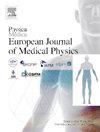锥形束ct引导自适应碳离子放射治疗胰腺癌每日重新规划的剂量学性能
IF 3.3
3区 医学
Q1 RADIOLOGY, NUCLEAR MEDICINE & MEDICAL IMAGING
Physica Medica-European Journal of Medical Physics
Pub Date : 2025-05-10
DOI:10.1016/j.ejmp.2025.104991
引用次数: 0
摘要
目的研究超低分割碳离子放疗(CIRT)治疗胰腺癌(PC)在锥形束ct引导下的适应性重规划是否能产生令人满意的剂量学结果,并探讨适应性方案的潜在剂量学优势。方法选择ct引导下行在线自适应光子放疗的PC患者6例。将数据导入CIRT治疗计划软件,以制定超低分割CIRT方案的新计划。使用线性二次模型分别对危险器官(OARs)和目标重新计算处方和约束。生物有效剂量-等效处方剂量设定为43.2 Gy(相对生物有效性[RBE])。每天,在计划CT (PCT)和每日CBCT的基础上生成合成CT (SCT)。将基于PCT的参考计划与基于SCT的调整计划进行比较。采用可变形图像配准对每日剂量进行求和。结果调整方案达到了临床目标,而参考方案在胃、十二指肠和小肠各部分中分别超出了27%、53%和31%。调整后的方案显著降低了所有胃肠道OARs的V35.5 Gy[RBE],同时显著提高了总肿瘤体积(GTV) D95%和计划靶体积(PTV) D90%。十二指肠vv35.5 Gy[RBE]、GTV D95%、PTV D90%的累积剂量均有显著改善。结论与非自适应CIRT方案相比,cbct引导下的自适应CIRT治疗PC显示出良好的剂量学结果,显著提高了OARs的保护,并确保了更好的靶覆盖。本文章由计算机程序翻译,如有差异,请以英文原文为准。
Dosimetric performance of cone beam CT-guided adaptive carbon-ion radiotherapy with daily replanning for pancreatic cancer
Purpose
We investigated whether an ultra-hypofractionated carbon-ion radiotherapy (CIRT) protocol for pancreatic cancer (PC) could produce satisfactory dosimetric results with or without cone-beam CT-guided adaptive replanning and explored the potential dosimetric advantages of the adapted protocol.
Methods
Eleven PC patients who underwent CBCT-guided online adaptive photon radiotherapy were selected. Data were imported into a CIRT treatment planning software to develop new plans for an ultra-hypofractionated CIRT protocol. Prescriptions and constraints were recalculated for a five-fraction schedule using a linear quadratic model for organs-at-risk (OARs) and targets, respectively. The biologically effective dose-equivalent prescribed dose was set at 43.2 Gy (relative biological effectiveness [RBE]). Each day, a synthetic CT (SCT) was generated from the planning CT (PCT) with the daily CBCT. A reference plan based on the PCT was compared to an adapted plan based on the SCT. Deformable image registration was used to allow summation of the daily doses.
Results
The adapted plans met the clinical goals, whereas the reference plans exceeded the constraints in 27 % (stomach), 53 % (duodenum), and 31 % (small bowel) of the fractions. The adapted plans notably decreased V35.5 Gy[RBE] for all gastrointestinal OARs, while significantly enhancing the gross tumor volume (GTV) D95% and planning target volume (PTV) D90%. The accumulated doses showed significant improvements in the duodenum V35.5 Gy[RBE], GTV D95%, and PTV D90%.
Conclusion
CBCT-guided adaptive CIRT for PC demonstrated favorable dosimetric results, notably enhancing the sparing of OARs and ensuring superior target coverage compared with non-adaptive CIRT protocols.
求助全文
通过发布文献求助,成功后即可免费获取论文全文。
去求助
来源期刊
CiteScore
6.80
自引率
14.70%
发文量
493
审稿时长
78 days
期刊介绍:
Physica Medica, European Journal of Medical Physics, publishing with Elsevier from 2007, provides an international forum for research and reviews on the following main topics:
Medical Imaging
Radiation Therapy
Radiation Protection
Measuring Systems and Signal Processing
Education and training in Medical Physics
Professional issues in Medical Physics.

 求助内容:
求助内容: 应助结果提醒方式:
应助结果提醒方式:


